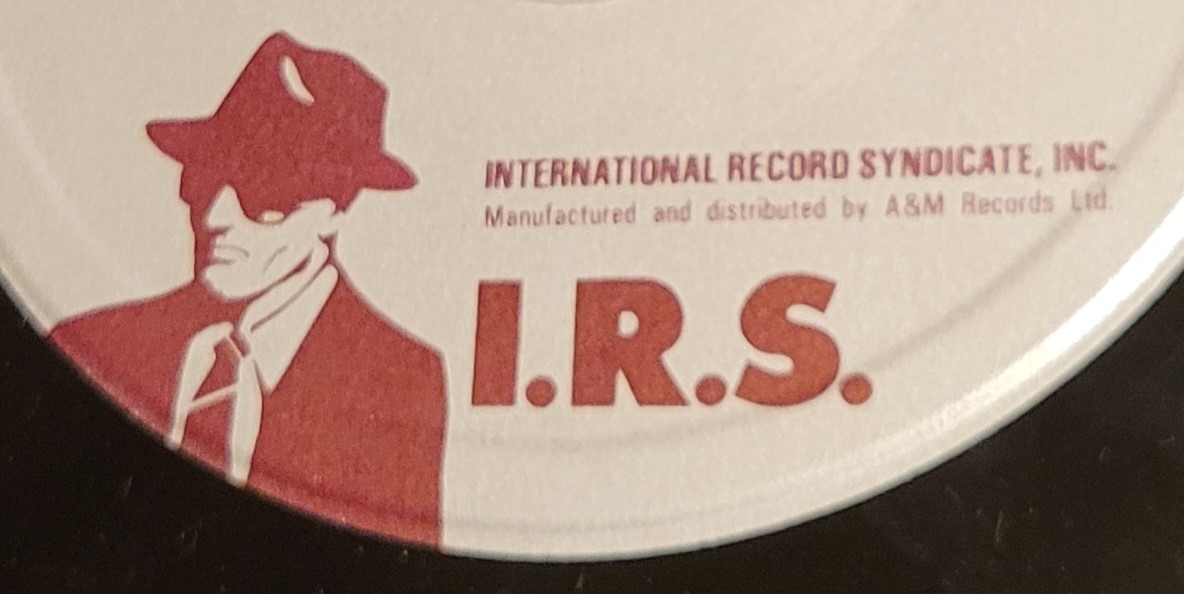A relatively short-lived record label in its original incarnation, I.R.S. Records was formed only in 1979 and folded in 1996. It was, therefore, very much an icon of the 1980s, blazing a trail through the music industry in that decade. A beacon for artists who trafficked in the avant-garde – those who preferred college rock, new wave, and the burgeoning sounds of alternative rock – I.R.S. didn’t just join a move toward these different sounds; it helped to lead it.

I.R.S.’s driving force was Miles Copeland III. Copeland is the brother of the Police drummer Stewart, and music promoter and agent Ian. They have a sister, Lorraine. Their father, Miles Copeland Jr., was a founding member of the CIA, but much more, he was a musician and businessman.
Anyway, enough Copeland family history, let’s get back to I.R.S. Records. Copeland’s sibling tie to Stewart meant that he was ideally placed to help manage the Police. Of the Police, Copeland would say that they had the attitude of Punk, but almost more importantly, all the necessary tools to make it as big as they eventually did.
In no small part, he assisted the fledgling band in getting their first single, Fall Out, released. Along with Stewart, and Paul Mulligan, the group’s manager, they had founded the label Illegal Records – the track was released on this label in 1977. Soon they had signed a deal with A&M Records and their first single for A&M was Roxanne, released in 1978.
The success of the Police, and his role in it, enabled Copeland to convince co-owner and co-founder of A&M Jerry Moss to distribute a US version of his UK labels like Illegal Records. Hence I.R.S. (International Record Syndicate) was formed in 1979.
Copeland recruited Jay Boberg, a concert promoter at UCLA, who had booked acts as diverse as Peter Gabriel, Talking Heads and Bob Marley. Between them, Copeland and Boberg initially concentrated on the emerging (UK) punk and new wave scene. For example, early releases included a Buzzcocks singles compilation, Singles Going Steady, Live at the Witch Trials by the Fall, and a Stranglers compilation IV.
Responsible for design and artwork was the design-savvy Carl Grasso. Although credited only as a quasi-co-founder of the label, he was responsible for its distinctive logo. He was also the person behind the illustration and art direction for hundreds of albums and single covers, plus cassettes, CDs, posters, ads and pretty much everything else for bands on the label.
Cultivating the Underground: I.R.S.’s Rise and Breakthrough (1979-1984)
An early signing to I.R.S. was a band from Athens, Georgia. Formed in 1980 by drummer Bill Berry; bassist Mike Mills; guitarist Peter Buck and singer Michael Stipe, R.E.M. were perhaps the original alternative rock band. A nod to this epithet is made by others, such as Nirvana, who could equally be described in the same way. R.E.M.’s first album, Murmur, was released on I.R.S. Records in 1983.
A college band, R.E.M. were all students at the University of Georgia, and they followed Murmur with Reckoning, Fables of the Reconstruction, Life’s Rich Pageant, and Document before releasing Green for Warner Brothers in 1988. They had left I.R.S. because of their perceived lack of faith in the label’s marketing effort.
The Go-Go’s, an all-American girl band from California, released three albums in the early 1980s on I.R.S. Records. Their most famous member is lead singer, Belinda Carlisle, but other members are Jane Wiedlin (rhythm guitar); Charlotte Caffey (keyboards and lead guitar); drummer Gina Schock and Kathy Valentine (bass guitar).

Along with the label’s other signings, both R.E.M. and The Go-Go’s were chosen for their unique sound that mainstream labels often overlooked. It’s this embracing of the unorthodox that led to The Go-Go’s debut album Beauty and the Beat, a release that turned heads with its fresh sound.
In addition to signing and promoting bands, I.R.S. underscored its commitment to nurturing the underground scene by targeting college campuses to find both bands and fans. This smart alignment with college radio became a distinctive feature of the label’s growth as it courted an audience that craved depth and diversity in music.
I.R.S. did marketing extremely well – Copeland had learned how to manage and market during his days as a student at the American University in Beirut in the late sixties. One of the bands that he had promoted was called Wichita Vortex Sutra – the first band in which his brother Stewart had featured. Consequently, I.R.S. propelled itself forward with innovative strategies that he had learnt during this time. They matched the energy of their vibrant artists with equally compelling promotional tactics, sparking conversations and building the I.R.S. brand as a seal of authenticity in the alternative space.
At the end of the British punk rock era, context is required regarding the makeup of the music industry. While giants ruled the airwaves with predictable hits, I.R.S. Records was eking out a space for different sounds to thrive. This determination to elevate alternative music became the label’s defining legacy, serving the artists and listeners hungry for a shift from the mainstream, their appetites whetted by British punk rock.
Reshaping Alternative Music: I.R.S. Records’ Golden Age (1985-1991)
During the mid-1980s to the early 1990s, I.R.S. Records heightened its influence within the realms of alternative soundscapes. The label was poised for prolific output and growth, nurturing a roster that included a convergence of established acts and emerging talents who would leave an indelible mark on the music landscape.
Success was amplified by artists such as the Fine Young Cannibals, whose polished blend of rock and soul climbed the charts, alongside The Alarm, and Timbuck 3, whose offerings significantly contrasted yet equally embodied the spirit of I.R.S.’s eclectic dynamic. The diverse nature of the label’s artists ensured a rich and varied catalogue, from the innovative folk-rock blends to the post-punk thrums resonating with listeners.
As music mediums evolved, I.R.S. Records sought to adapt. For example, the short-lived No Speak imprint was formed to release instrumental music and Tribal America was founded by Rob di Stefano to release more progressive electronic material that was all the rage in New York clubs of the 1990s. These imprints explored territories beyond their established brand, ensuring a creative injection into folk, alternative country, and electronica, drawing in a wider audience.
The cultural reach of I.R.S. Records was undeniably broadened through strategic placements. A spotlight shone on the label’s acts on MTV, which was an influential medium for music consumption during the period. Soundtrack contributions also became the vehicles through which their alternative aesthetics were channelled into mainstream culture, signifying their cultural resonance that extended beyond mere audio experiences.
Demonstrating the range of artists that I.R.S. Records released, Black Sabbath signed for the label in 1988 having been dropped by Warner Bros. Records. Copeland had persuaded Tommy Iommi to sign with the promise of artistic licence. They released 5 albums on the label from 1989’s Headless Cross to 1995’s Forbidden.
Unfortunately, I.R.S. was to shine only briefly. Always fluid, in the 1990s, the ever-changing music industry was affected by the advent of grunge and a general migration of alternative rock towards the folds of larger labels.
In Conclusion: The Timeless Echo of I.R.S. Records
The influence of I.R.S. Records on the music industry is far larger than its relatively short-lived existence. The label’s unwavering commitment to nurturing alternative sounds has left a profound legacy.
In the grand narrative of alternative rock’s evolution, I.R.S. Records stands out as a pioneer and trendsetter. It transformed the way the world engaged with genres that, at the time, were on the cultural fringe. In bringing bands like R.E.M. into the limelight, I.R.S. Records was at the right place at the right time, assisting in the birth of the alternative rock movement.
But the story of I.R.S. Records goes beyond its catalogue of groundbreaking music. It shaped broader cultural trends, serving as a vessel for social commentary and a barometer for the spirit of an era. In its heyday and through its difficulties, I.R.S. Records maintained a spirit that seemed to echo the very essence of the alternative genre it championed: defiant, pioneering, and endlessly creative. And while the label itself has ceased to release new music; its back catalogue stands scrutiny with any other in the music industry.
After its closure in 1996, I.R.S. Records was revived in 2015, with an emphasis on archival releases and reissues of that back catalogue. As a result, its music – and the revolutionary spirit it embodied – will not be forgotten as new fans find R.E.M.’s Fables of the Reconstruction or the Alarm’s Declaration.

I hope that you can now see that more than just a record-selling entity, I.R.S. Records was a cultural icon. Its influence cannot be confined to a single genre – cf. for example, the contrasting sounds of Black Sabbath and Fine Young Cannibals. Instead, through its back catalogue, it continues to resonate, offering a testament to the power of music to define and unite generations. I.R.S. Records reminds us that at the core of all memorable music is its ability to speak out, connect, and endure.


Hi Simon, thanks for your extensive and informative article about I.R.S. Records. I must admit, although I’m familiar with many of the artists, I was unaware of the existence of I.R.S. I do know that in the 70’s the contemporary music climate began to change. Prior to that, contemporary music was all grouped as the same-something young people listened to. I’m old enough to remember those days. Alternatives and different genres emerged and continue to not only exist but to thrive. I.R.S contributed greatly to that as you have written.
Bob
Thanks for your comment, Bob. I came to REM late – probably after they had already made the move to Warner Bros. But I was always a big fan of the Police and it was interesting to learn their part, however incidental it was, in the foundation of I.R.S.
Simon